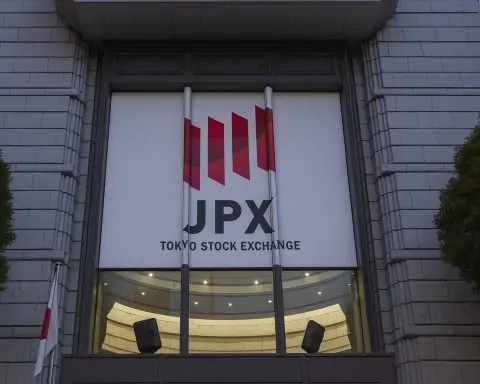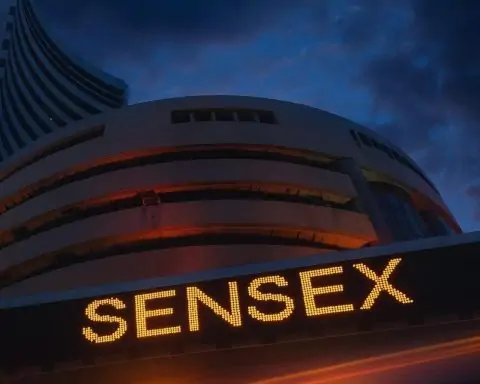Global markets are ending Tuesday deep in the red as investors suddenly question whether the artificial intelligence boom has morphed into a full‑blown AI bubble. From New York to London and Tokyo, the same theme is driving prices lower: AI spending, AI valuations and AI expectations may finally have run too far, too fast. [1]
A Fourth Straight Day of Losses as AI Trade Unravels
On Wall Street, the sell‑off accelerated into the close. The Dow Jones Industrial Average dropped about 498 points (roughly 1%), the S&P 500 fell around 0.8%, and the tech‑heavy Nasdaq slid about 1.2%, marking a fourth consecutive day of losses. [2]
The declines were once again led by the market’s AI champions:
- The “Magnificent Seven” — Alphabet, Amazon, Apple, Meta, Microsoft, Nvidia and Tesla — all came under pressure as investors reassessed how much of their recent gains were driven by AI euphoria. [3]
- Nvidia, the poster child of the AI chip boom, is now down roughly 8–10% so far in November after another pullback today. TechStock²
Europe and Asia mirrored the U.S. slump:
- The pan‑European STOXX 600 index fell about 1.8%, its steepest daily drop since August and a one‑month low, with banks, autos and miners all sliding as AI‑linked tech stocks joined the decline. TechStock²+1
- London’s FTSE 100 lost around 1.3%, its worst session since early April, while France’s CAC 40 and Germany’s DAX each fell close to 1.7–1.9%. TechStock²+1
- In Asia, chip‑heavy markets were hit hard, with Japan’s Nikkei 225 and South Korea’s Kospi both down more than 3% as investors cut exposure to the global semiconductor and AI supply chain. TechStock²
Risk aversion is spilling into other speculative areas as well. Bitcoin briefly traded below $90,000, down sharply from near $125,000 last month, while gold, oil and other assets have also turned volatile in recent sessions. [4]
How AI Hype Took Over the Market
To understand why “AI bubble” fears are suddenly dominating headlines, it helps to look at how central artificial intelligence has become to the 2025 market story.
AI‑linked stocks have powered a huge share of this year’s gains:
- CBS MoneyWatch notes that roughly 37% of the S&P 500’s total market value now sits in the Magnificent Seven, whose fortunes are tightly bound to AI. [5]
- Analysts estimate that the AI rally alone has added many trillions of dollars to global equity markets since late 2022 — and that AI‑themed names have recently lost about $1.8 trillion from their peaks as the latest sell‑off deepens. [6]
At the same time, the infrastructure behind AI has turned into one of the biggest capital‑spending booms in modern history. Tech giants are pouring hundreds of billions of dollars into:
- Data centers packed with AI accelerators and GPUs
- High‑voltage power lines and backup generation to feed those facilities
- Massive cloud‑computing contracts with AI labs and enterprise users [7]
That spending surge has priced perfection into many AI‑exposed stocks. When growth expectations are sky‑high, even a small wobble in confidence can trigger a violent repricing — exactly what markets are now experiencing.
Fund Managers Now Call an “AI Bubble” Their Top Tail Risk
One of the clearest catalysts for today’s anxiety is fresh data showing that professional investors themselves are suddenly more worried about an AI bubble than almost anything else.
Bank of America’s latest global fund manager survey, cited by multiple outlets, finds that:
- 45% of fund managers now see an AI bubble as the top “tail risk” — a low‑probability but high‑impact event — for global markets.
- That concern ranks ahead of bond‑market stress, inflation and trade wars, and it coincides with the highest net share in 20 years of investors saying companies are “overinvesting” in capex, much of it for AI chips and data centers. [8]
In other words, the people actually allocating capital are increasingly worried that corporate AI budgets — and AI‑related valuations — are running ahead of reality.
Goldman Sachs analysts have added fuel to those concerns, warning that the stock market may already have fully priced in the AI boom, with roughly $19 trillion in market value tied to AI expectations that have yet to show up in the real economy. [9]
Tech Insiders Sound the Alarm: “No Company Is Going to Be Immune”
It’s not just portfolio managers flashing warning signs. Some of the world’s most powerful tech executives are openly acknowledging bubble risks.
In an interview published today, Alphabet and Google CEO Sundar Pichai told the BBC and Reuters that the current wave of AI investment is an “extraordinary moment” but one with “elements of irrationality” reminiscent of late‑1990s dot‑com excess. [10]
Asked what would happen if an AI bubble bursts, Pichai said Alphabet could weather the storm but warned that “no company is going to be immune, including us.” [11]
Other tech leaders are voicing similar worries:
- Klarna CEO Sebastian Siemiatkowski has said he is “very nervous” about the scale of data‑center investments, arguing that more efficient AI models, such as those developed by Chinese firm DeepSeek, could leave today’s energy‑hungry infrastructure badly overbuilt. [12]
- A Common Dreams report notes that some big‑name investors, including SoftBank, Peter Thiel’s hedge fund and Michael Burry of “The Big Short” fame, have recently sold Nvidia stakes or taken short positions, viewing the stock as emblematic of AI froth. [13]
When the same executives who are betting their companies on AI start warning about over‑investment and irrational pricing, markets listen.
AI Bubble Jitters Spread Into Credit and Crypto
Another reason today feels different: AI worries are no longer confined to equities.
A Bloomberg analysis finds that risk premiums on U.S. corporate bonds — from high‑grade issuers to junk borrowers — are hovering near their highest levels in weeks. In several recent bond deals, about 40% of investor orders were pulledonce final pricing was set, and one investment‑grade offering was canceled outright — an unusual sign of stress in what is normally a stable part of the market. [14]
This tightening of credit conditions is happening just as:
- Semiconductor stocks slide
- Crypto markets shed more than a trillion dollars in overall value since their recent highs
- Volatility indices in both Europe and the U.S. spike to one‑month highs TechStock²+2TechStock²+2
Together, these moves suggest investors are reducing exposure not only to AI stocks but to a broader ecosystem of speculative and AI‑adjacent assets.
Mega AI Deals No Longer Guarantee Soaring Stocks
One striking feature of today’s market action is how huge AI announcements now struggle to excite investors — a classic late‑cycle warning sign.
On Tuesday, Nvidia and Microsoft unveiled a massive new partnership with AI startup Anthropic, under which: [15]
- Anthropic will commit to $30 billion in Microsoft cloud spending and up to 1 gigawatt of additional computing capacity.
- Nvidia’s latest Grace Blackwell and Vera Rubin systems will power much of that capacity.
- Nvidia and Microsoft plan to invest up to $10 billion and $5 billion, respectively, in Anthropic.
Deals like this used to send AI stocks rocketing higher. Instead:
- Nvidia shares were down more than 1% in early‑afternoon trading and have fallen about 10% this month.
- Microsoft slipped roughly 3%, extending its pullback from recent record highs. [16]
Investopedia notes that a web of similar commitments — multi‑billion‑dollar chip purchases, long‑term cloud contracts, cross‑investments between AI labs and infrastructure providers — is making some on Wall Street question whether headline deal values overstate real end‑user demand for AI services. [17]
A separate TS2 report highlights CoreWeave, a key AI cloud provider backed by Nvidia, whose stock has been extremely volatile in recent days as investors question whether parts of the AI infrastructure trade are “dangerously overheated.” TechStock²+1
Are We Really in an AI Bubble? Why Some Say It’s “Not 2000 All Over Again”
Despite the dramatic price action, not everyone agrees that today’s sell‑off proves AI is in a classic bubble.
Several major research houses argue that valuations are elevated but not yet at dot‑com extremes:
- BlackRock’s iShares unit calculates that at the peak of the dot‑com era, the top four tech giants (Microsoft, Cisco, Intel and Oracle) traded around 70× two‑year forward earnings.
- Today, by contrast, the biggest AI datacenter spenders — Microsoft, Alphabet, Amazon and Meta — trade at roughly 26× two‑year forward earnings on average. [18]
CBS MoneyWatch likewise notes that the current price‑to‑earnings ratios of the Magnificent Seven are about half the levels reached by the largest stocks at the height of the late‑1990s bubble. [19]
Federal Reserve Chair Jerome Powell has also pushed back against easy comparisons to 2000, saying that the most highly valued companies today “actually have earnings,” unlike many of the revenue‑less dot‑coms that collapsed 25 years ago. [20]
iShares argues that:
- AI data centers are being built in response to real, exponential growth in demand for compute, not purely speculative business plans.
- Most of the spending is financed by established, cash‑generating giants rather than debt‑heavy startups. [21]
In this view, the AI theme may be over‑owned and over‑hyped, but not obviously a bubble destined to collapse in the same way as Pets.com or other dot‑com casualties.
What a Bursting AI Bubble Could Mean
Even if today’s AI trade isn’t a carbon copy of 2000, a sharp and sustained reversal would still have wide‑ranging consequences.
Given how intertwined AI is with the broader economy, a severe unwinding could:
- Hit equity indices hard
With AI leaders making up such a large share of the S&P 500 and other benchmarks, a deeper slide in these names would drag down retirement portfolios and index funds worldwide. [22] - Force companies to slash capex
If investors revolt against multi‑billion‑dollar data‑center plans, big tech firms could slow or cancel projects, affecting chipmakers, construction companies, utilities and local economies built around AI campuses. [23] - Tighten credit further
As Bloomberg’s credit analysis shows, bond investors are already demanding higher yields from corporate borrowers. A full‑blown AI bust could push spreads wider, make refinancing harder and pressure leveraged firms across sectors. [24] - Cool innovation — at least temporarily
Startups that rely on easy access to capital for AI experiments could face funding droughts if sentiment sours, slowing the pace at which new models and applications reach the market.
Pichai’s warning that “no company is going to be immune” captures the core risk: AI has become so deeply embedded in investment plans and expectations that a sharp reversal would ripple far beyond Silicon Valley. [25]
How Investors Are Responding Right Now
Today’s market action and recent surveys suggest that investors aren’t abandoning AI entirely — they’re re‑pricing and re‑balancing.
Key shifts include:
- Rotation into safer assets: Money‑market funds, Treasuries and defensive sectors have attracted inflows as investors hedge against further volatility in AI‑heavy tech. TechStock²+1
- Greater selectivity within AI: Many analysts now stress the importance of focusing on companies with durable cash flows, strong balance sheets and clear AI monetization paths, rather than pure “AI story stocks.” [26]
- Hedging exuberance: Options activity and short interest in some AI leaders — most notably Nvidia — have increased as sophisticated investors seek protection or express skepticism about current pricing. [27]
As one economist told CBS, “The stock market is a giant bet on AI right now,” driven disproportionately by a small group of mega‑cap names. [28] That concentration makes both the upside and the downside of the AI narrative unusually powerful.
What to Watch in the Days Ahead
For anyone tracking the AI bubble debate after today’s sell‑off, several catalysts loom large:
- Nvidia earnings (tomorrow): The company’s guidance on AI chip demand, data‑center spending and pricing will be a crucial test of whether recent fears are justified or overdone. TechStock²+1
- Corporate capex updates: Upcoming results from cloud providers, chipmakers and utilities will show whether management teams are sticking to their AI build‑out plans or quietly trimming budgets. [29]
- Credit‑market health: Watch for more canceled or downsized bond deals, which would signal rising stress as investors demand higher compensation to fund corporate AI ambitions. [30]
- Regulatory and policy moves: European and British policymakers have already flagged AI bubble risks; further commentary from regulators or central banks could influence how aggressively markets re‑price AI assets. [31]
Bottom Line: A Reality Check, Not (Yet) the End of AI
18 November 2025 may go down as the day AI optimism finally met serious skepticism. Market action, survey data and executive commentary all point in the same direction: the era of unquestioned AI euphoria is over.
Whether this proves to be:
- a healthy correction after a runaway rally,
- the early stage of a longer, grinding de‑rating, or
- the start of a true AI bubble bursting
will depend on whether companies can translate today’s gigantic AI investments into durable profits and genuine productivity gains over the next several years.
For now, investors are being forced to separate AI as a transformational technology — which most experts still believe in — from AI as a limitless stock‑market story, which today’s sell‑off shows is facing its most serious test yet. [32]
This article is for informational purposes only and does not constitute financial, investment or trading advice. Always conduct your own research or consult a licensed financial professional before making investment decisions.
References
1. abcnews.go.com, 2. abcnews.go.com, 3. abcnews.go.com, 4. www.cbsnews.com, 5. www.cbsnews.com, 6. www.investors.com, 7. abcnews.go.com, 8. www.cbsnews.com, 9. finance.yahoo.com, 10. www.reuters.com, 11. www.reuters.com, 12. www.commondreams.org, 13. www.commondreams.org, 14. www.bloomberg.com, 15. www.investopedia.com, 16. www.investopedia.com, 17. www.investopedia.com, 18. www.ishares.com, 19. www.cbsnews.com, 20. www.cbsnews.com, 21. www.ishares.com, 22. www.cbsnews.com, 23. www.investopedia.com, 24. www.bloomberg.com, 25. www.reuters.com, 26. www.ishares.com, 27. www.commondreams.org, 28. www.cbsnews.com, 29. www.ishares.com, 30. www.bloomberg.com, 31. www.reuters.com, 32. www.ishares.com







